Share this
Breaking Down An In-Line Printing Press
by Luminite on Oct 3, 2022 4:29:53 PM
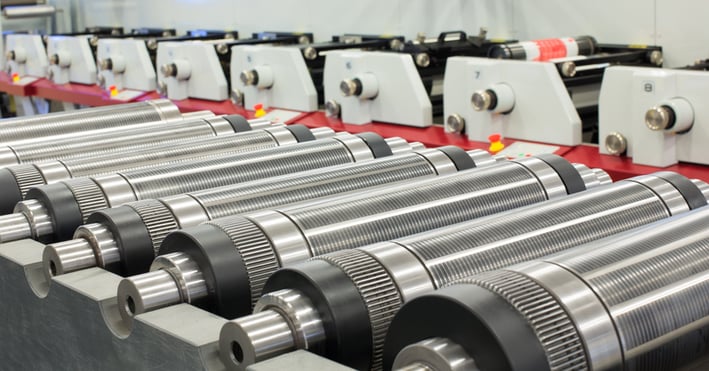
Editor’s Note: This article is the first in a series evaluating three types of printing presses. Check out our other installments on central impression and stack presses.
With a wide range of substrate materials & sizes, as well as a plethora of different applications, different styles and types of printing presses exist to serve the wide-ranging flexographic printing industry.
Of all the press types, the most common flexo press found throughout print houses are inline printing presses.
To garnish the full potential of your artwork and ensure that your printer’s inline-press is capable of handling the design of your next product packaging, poster, or other goods, it’s important to have a thorough understanding of the components/sections of an in-line press and how they operate together.
Below, we’ll break down the 6 major components of an inline flexo printing machine.
Diving In: Parts of an In-Line Printing Press
With the printing industry reaching nearly $80 billion in 2022, it’s no surprise that different shapes, styles, and sizes of printers exist.
While commercial-size inkjet printers and a multitude of different full-scale printing presses have grown in popularity, inline flexographic presses are still the most commonly found presses throughout the printing industry. To better understand these presses, it’s important to understand each component and its operation.
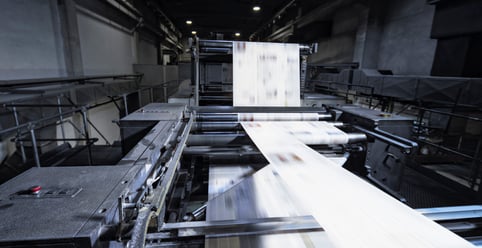
An Inline flexographic press has six main sections:
- Unwind and Infeed
- Enclosed Doctor Blade Inking System
- Inking Anilox Roller
- Image Carrier and Impression Cylinder
- Dryer
- Outfeed and rewind
Together, these six components operate in tandem with each to create a seamless printing system that can handle mass runs on a variety of substrates. Each section plays a vital role in the production of the printed goods.
- Unwind and Infeed - A roll of the substrate is fed into the printing press. Tension must be kept taught to prevent slack which can cause wrinkling, misregistration, web breaks, and other print defects.
- Enclosed Doctor Blade Inking System - A continuous cycling pump fills the enclosed chamber with ink. The ink is transferred onto the anilox roll with any excess removed by the doctor blade. The ink cycles in and out of the enclosed system during printing.
- Inking Anilox Roller - The anilox roller contains microscopic cells which carry a thin layer of ink from the inking system to the image carrier. There are 4 main types of inks that you can use - water-based, solvent-based, oil-based, and UV inks. Finding the right ink composition is important for anilox and image carrier material selection.
For more information on what type of ink will work best for your applications, check out our free Ink guide below: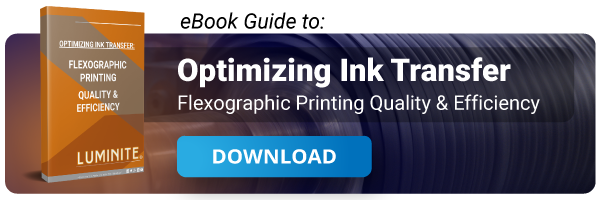
- Image Carrier and Impression Cylinder - The image carrier transfers the image to the substrate. The flexographic press pulls the substrate between the image carrier and the impression cylinder. Simultaneously, the impression cylinder holds exactly the right amount of pressure on the substrate for even ink distribution.
- Drying - The substrate winds through roller-less and plate-less sections to dry the ink. Depending on the number of colors used, the substrate might pass through multiple image carriers, impression cylinders, and drying sections in a single print run (one per color).
- Outfeed and Rewind - The final step on a flexographic printing press is the outfeed and rewind, where a substrate is rolled up again in preparation for a cutting die, which will separate individual prints.
Inline Flexographic Printing Machines | Image Carrier Services
An important component to any flexographic printing press is the image carrier.
To create an image carrier, there is some variance in the process dependent on customer requirements such as elastomer selection, adhesive requirements, dimensional considerations, and more -- However, the majority of image carrier services follow the steps below:
- Receiving / Incoming Inspection
- Base Preparation
- Rubber Wrap
- Autoclave / Vulcanization
- Rough Grind
- Trim
- Finish Grind
- Polishing
- Laser Engraving
- Print Proof
- Final Clean-up
- Final Inspection
- Shipping
For more information on the image carrier creation process, check out our blog detailing a behind-the-scenes look at Flexographic Image Carrier Production.
As time progressed, Flexo industry thinkers have continually returned to the drawing board to increase productivity and quality, and achieve:
- More press uptime
- Higher speeds
- Continuous print
- Fewer printing defects
- Less time troubleshooting
- Less waste
- Brighter colors
- More diverse capabilities
From those discussions and improvements came Direct laser engraving (DLE) elastomer sleeves.
DLE elastomer sleeves are an integral part of any current-day flexographic operation as they
- Increased production speed
- Have fewer registration issues
- Result in high definition and clear prints
- Reduced waste and related costs
With direct laser-engraving technology and ITR elastomer, print houses can achieve high-end print results in a fraction of the time.
To find more information on DLE’s and their benefits, check out our recent blog “4 Ways Direct Laser Engraving Aids Flexo Printing Quality & Efficiency”
Flexographic Printing | Choosing The Right Image Carrier
One of the most challenging aspects of operating an inline flexo printing press is identifying where a printing defect is occurring. While recognizing the type of defect may be as simple as looking at your prints, figuring out where the defect is occurring, and why can be challenging.
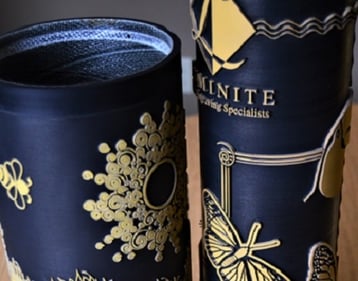
Working with image carrier providers with a proven track record of success is important for the longevity and success of your print runs.
While Image carrier services typically include the manufacturing of sleeves, cylinders, and plates, top-of-the-line manufacturers also offer support to the press operators when defects and challenges arise.
Luminite Product Corporation has provided high-quality, long-lasting products for the flexographic industry since 1926.
Have questions about the image carriers' role in inline flexographic operations? Are you experiencing printing defects during your press runs?
Consult the experts with over 100 years of experience in the printing industry! Contact Luminite today or check out our new Flexo 101 Resource Hub below, your one-stop shop for Flexo resources, guides, and more!
Share this
- Flexographic Printing (81)
- Image Carrier (28)
- Elastomer sleeves (27)
- Ink Transfer (25)
- Quality (22)
- Flexo sleeve (20)
- News (18)
- printing defects (18)
- flexo printing defects (17)
- sustainability (13)
- Flexo Troubleshooting (12)
- Ink (12)
- Digital Printing (10)
- Flexo 101 (10)
- Flexo Inks, (9)
- Anilox (7)
- Blister Packaging (7)
- Cost (6)
- print misregistration (6)
- regulations (6)
- Corrugated Printing (4)
- pinholing (4)
- "Tradeshow (3)
- Digital Flexo (3)
- Gravure Printing (3)
- Insider (3)
- Load-N-Lok (3)
- Wide Web (3)
- direct laser engraving (3)
- flexo-equipment-accessories (3)
- gear marks (3)
- halo (3)
- testing (3)
- Narrow Web (2)
- bridging (2)
- feathering (2)
- filling in (2)
- mottled image (2)
- pressure (2)
- Labelexpo (1)
- dirty prints (1)
- doughnuts (1)
- embossing (1)
- kiss impression (1)
- October 2023 (2)
- September 2023 (1)
- August 2023 (1)
- July 2023 (3)
- June 2023 (1)
- May 2023 (5)
- April 2023 (1)
- March 2023 (2)
- February 2023 (1)
- January 2023 (3)
- December 2022 (1)
- October 2022 (3)
- September 2022 (2)
- August 2022 (2)
- July 2022 (3)
- May 2022 (1)
- April 2022 (4)
- March 2022 (2)
- February 2022 (5)
- January 2022 (7)
- December 2021 (1)
- November 2021 (3)
- October 2021 (2)
- September 2021 (1)
- August 2021 (1)
- July 2021 (3)
- June 2021 (1)
- May 2021 (4)
- April 2021 (4)
- March 2021 (4)
- February 2021 (2)
- December 2020 (1)
- November 2020 (1)
- October 2020 (2)
- September 2020 (1)
- August 2020 (3)
- July 2020 (2)
- June 2020 (3)
- May 2020 (1)
- April 2020 (1)
- November 2019 (3)
- October 2019 (1)
- August 2019 (1)
- July 2019 (1)
- April 2019 (1)
- March 2019 (1)
- January 2019 (1)
- October 2018 (2)
- August 2018 (1)
- July 2018 (1)
- June 2018 (1)
- February 2018 (2)
- October 2017 (1)
- September 2017 (2)
- January 2016 (1)
- February 2015 (1)
- January 2015 (1)
- December 2014 (2)
- September 2014 (1)
- February 2014 (1)
- January 2014 (1)
- December 2013 (3)
- October 2013 (1)
- September 2013 (1)
- June 2013 (1)
- January 2013 (1)

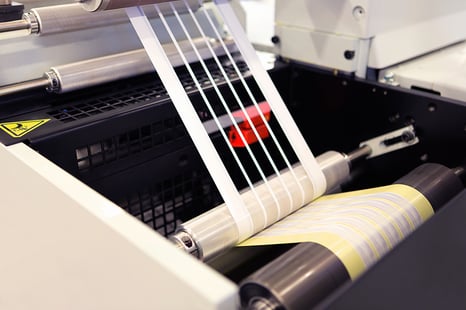
Comments (2)